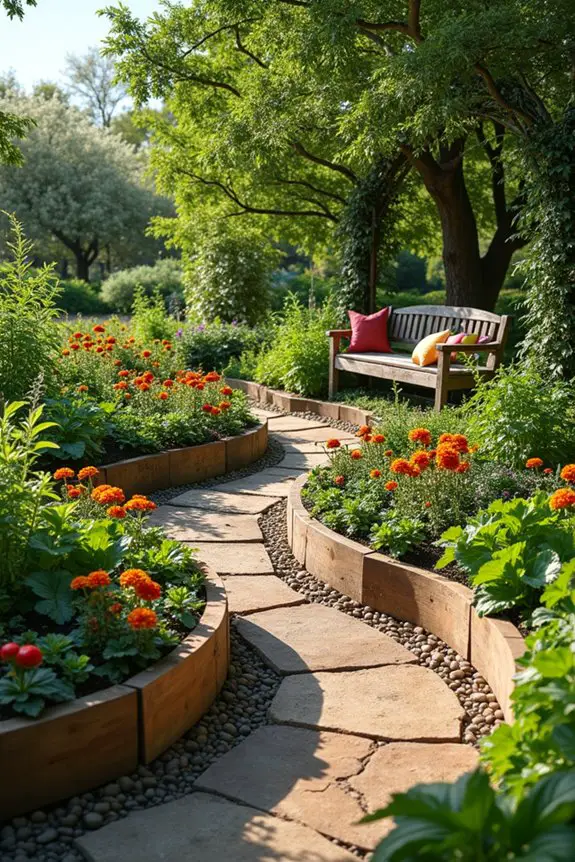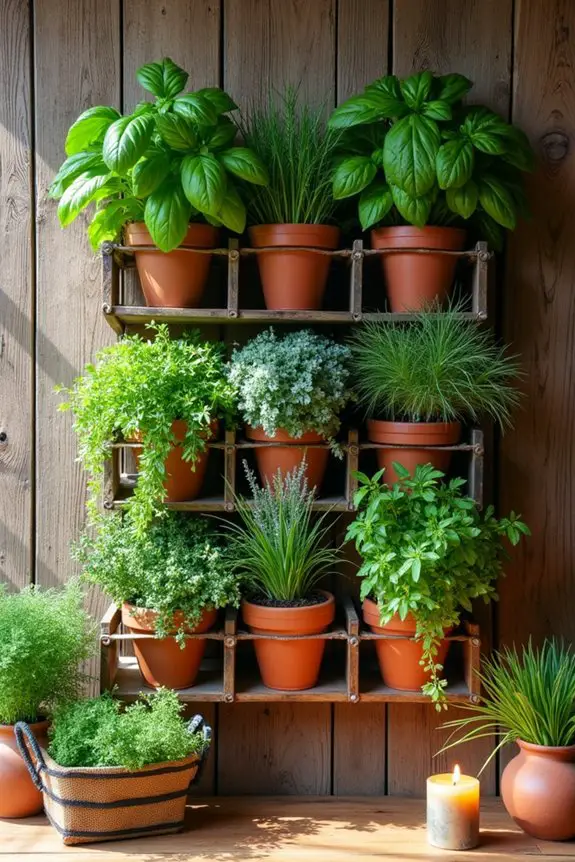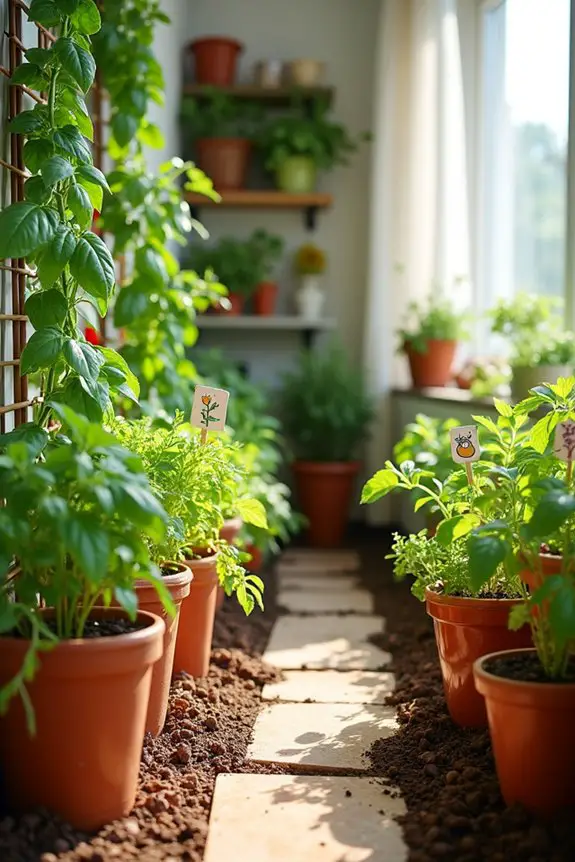So, you want to create a garden that’s both pretty and practical, huh? You’re in the right place. Imagine lush veggies sprouting alongside colorful flowers, all designed to attract helpful critters instead of the pesky ones. Picture swooping curves and creative plant pairings, like tomatoes cozying up with basil. Sounds nice, right? Stick around because I’ve got ten stellar design ideas that’ll take your veggie garden from blah to breathtaking, and you won’t want to miss a single one.
Vegetable Block Planting Strategy
When you’re planning your vegetable block planting, think about how a curved bed arrangement can really spice things up.
It’s not just about fitting in as many plants as possible; mixing colors with companion planting can turn your garden into a little edible art piece.
Plus, functional borders and eclectic pairings? They not only look great, but they also create a cozy little ecosystem right in your backyard—now that’s a win-win, right?
1. Curved Bed Arrangement
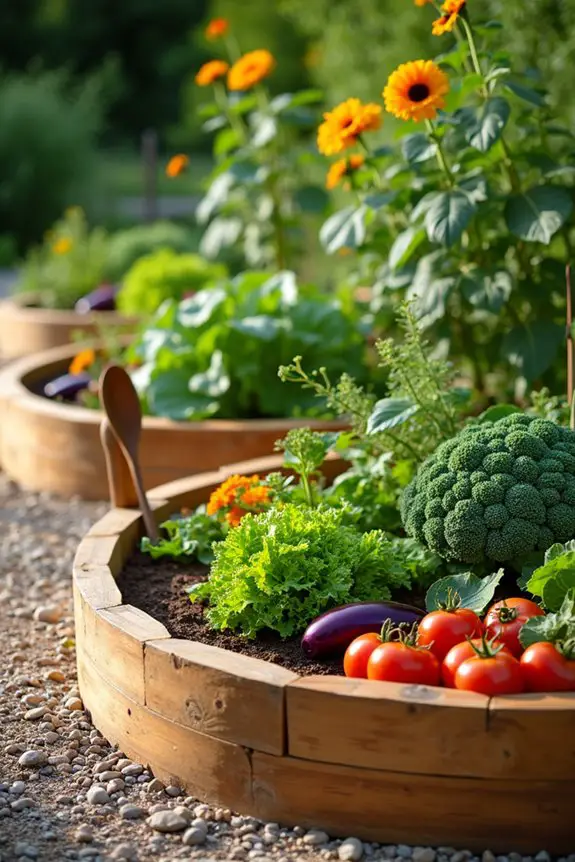
Curved beds in a vegetable garden are a fantastic choice for anyone looking to mix functionality with style. Think about it: those smooth, flowing lines aren’t only easier on the eyes but also super practical! They fit around landscape features and create cozy nooks for your plants, making it easy to access everything without stepping on your precious soil.
Imagine walking through your garden, with raised, crescent-shaped beds cradling vibrant vegetables. It feels like a stylish adventure, doesn’t it? You can plant your tomatoes here, a splash of rainbow chard there, all within arm’s reach.
And the best part? Those curves can help hold moisture better and minimize weed growth, so you spend less time battling Mother Nature and more time enjoying the fruits of your labor. To enhance your gardening experience, consider using a wood raised bed kit to create the perfect raised edges that help maintain your plants’ health and make everything look fabulous! Additionally, a metal raised bed kit offers durability and a modern aesthetic that can elevate the overall design of your garden.
Now, how do you get started? First, outline your desired shape in your garden with a garden hose or string. You want it to meander in a way that feels organic, kind of like a gentle river flowing through your backyard.
Next, get to work on your soil, giving it some love with compost and a bit of tilling. Once that’s set, you can build raised edges using wood or stone to keep everything contained (and to make it look fabulous while you’re at it).
Don’t forget to mix in some companion plants for an instant aesthetic boost. For instance, planting marigolds alongside your veggies can be a game changer. They not only look pretty but also help keep pests away—talk about a win-win!
2. Functional Border Planting
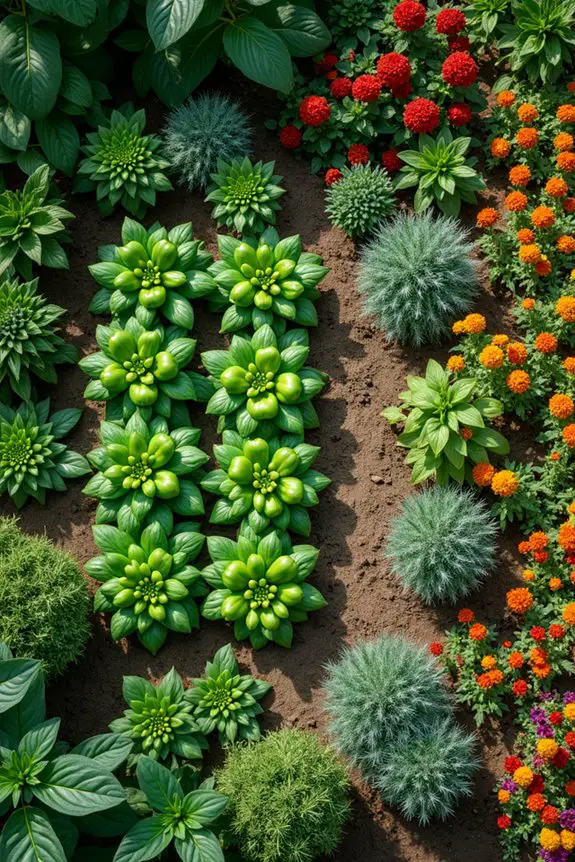
Functional border planting is a smart and stylish way to enhance your vegetable garden. Envision this: rows of vibrant veggies framed by colorful, low-growing plants! Not only does it create an eye-catching border, but it also serves some fantastic purposes. Functional border planting helps to define your garden space, protects your vegetables from pests, and can even attract beneficial insects—who wouldn’t want their chef-curated crops to be in a safe zone?
So, how do you bring this idea to life in your garden? Start by selecting plants that complement your main veggie block. Think about herbs like basil or lavender, which not only smell divine but also repel some critters. You can also go for low-growing flowers, like nasturtiums or marigolds. They’re vibrant and, spoiler alert: they double as edible treats! Just imagine plucking a nasturtium flower to add a splash of color to your salad—pretty fancy, right?
Next, outline your borders with these plants, either in simple straight lines or more fun, curved shapes if that fits your style better. Aim to plant them about a foot apart, so they’ve enough space to spread out and shine without being too crowded.
And a little pro tip: make sure your border plants have similar water and light needs as your veggies. That way, they can thrive together in happy harmony.
As your border plants grow, they’ll not only frame your veggie paradise but also create a soft, lush change that invites you in. Plus, tending to them is a great way to sneak in a bit of mindfulness—you might find yourself pausing just to inhale that delightful herb aroma.
Who knew gardening could also feel so indulgent? Remember, a beautiful border isn’t just about looks; it’s also about building a thriving ecosystem right in your backyard. So roll up those sleeves, dig in, and let your garden grow into the charming, bustling sanctuary you’ve always wanted!
3. Eclectic Plant Pairing Techniques

When you think about maximizing your garden space, eclectic plant pairing through vegetable block planting is a total game-changer. It’s not just about cramming as many veggies as possible into a square foot; it’s a form of art that brings whimsy and creativity into your garden, kind of like a colorful quilt made of cucumbers and tomatoes. This method makes sure your garden is both productive and visually stunning. Additionally, using tomato fertilizer spikes can provide essential nutrients that enhance the growth of your tomato plants.
Start by planning your blocks. Imagine compact clusters of different vegetables growing together—like a dinner party of flavors right in your yard! For example, consider throwing some radishes in with your carrots. They both love similar soil conditions, and the radishes mature quickly, paving the way for the slow-grown carrots. Talk about a dynamic duo.
And if you’re feeling adventurous, why not mix in some marigolds for that vibrant splash of color while keeping pesky insects at bay?
When planting, arrange your blocks closely together, about 12 inches apart. This allows those plants to share their nutrients and help each other thrive.
Oh, and don’t forget to think about heights—tall plants like tomatoes can easily cast shade over shorter ones like lettuce, but not too much shade, because let’s be honest, a wilty head of lettuce is kind of sad, right?
Watering is a cinch too. With densely packed blocks, you can just fill up your watering can and let it flow! Just be cautious, as some plants might like a little less love than others. Additionally, keeping your citrus trees well-fed with citrus tree fertilizer can significantly enhance the overall health and productivity of your garden.
Keep your eye on each group’s hydration needs to prevent any “soggy sadness” in your garden.
4. Colorful Companion Planting
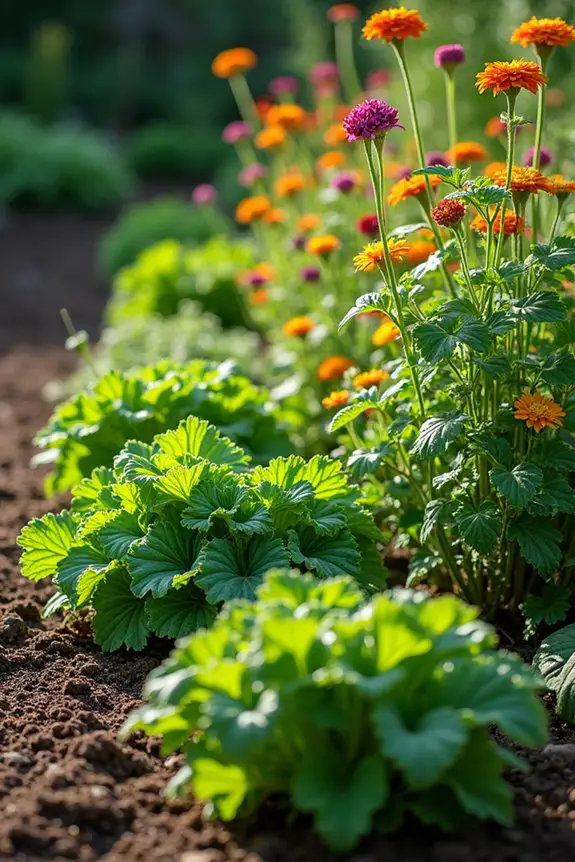
When it comes to vegetable gardening, pairing colors as well as flavors can create a vibrant, productive space in your yard. Companion planting not only enhances your vegetables’ growth but also creates a playful and lively atmosphere.
Imagine walking through a garden where bright orange marigolds mingle with deep green basil and rich purple eggplants—it’s like a culinary rainbow!
To get started, place your plant blocks side by side but don’t get too crowded. About 12 inches apart is usually just right!
Consider pairing plants that benefit each other—like the classic combo of tomatoes and basil. Besides their tasty friendship on a pizza, basil helps repel tomato pests. Talk about a dynamic duo.
Or how about mixing in some easily grown leafy greens, like spinach or kale, alongside your taller crops? They’ll appreciate the shade while you harvest both beauty and bounty.
Don’t forget to add some pops of color! Maybe toss in some nasturtiums; they’re stunning and delicious.
And for the fun of it, you might choose to plant some zinnias in between your vegetable blocks. Not only does it look gorgeous, but it also invites helpful pollinators to your garden party.
Just imagine the buzzing of bees and flutters of butterflies as you stroll through your masterpiece.
5. Colorful Edible Plant Arrangements
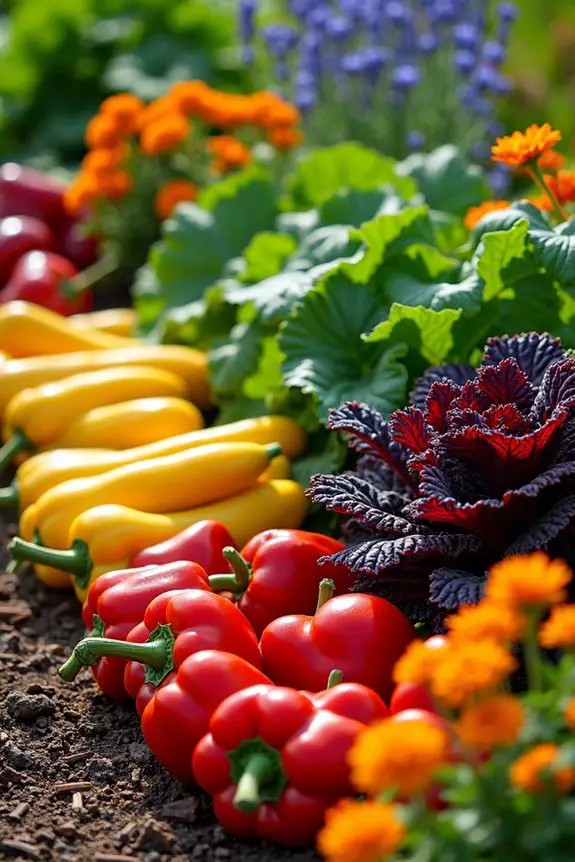
If you want to create a garden that’s not just a feast for the taste buds but also for the eyes, consider arranging your vegetable blocks with color in mind. This idea works wonders for maximizing both space and aesthetics, giving your garden that “wow” factor while producing fresh ingredients for your meals.
Think vibrant yellows, rich purples, and deep greens all working together—your garden can transform into a natural masterpiece.
Start by visualizing your blocks like a painter’s canvas. You can create harmonious color schemes or striking contrasts—whatever inspires you. For example, you could plant bright red peppers next to golden yellow squash. Not only do they look stunning together, but they also help each other thrive.
But hey, don’t just place them randomly. Give each plant a little room to breathe—around 12 inches apart is a good rule of thumb. You wouldn’t want a veggie traffic jam, would you?
Here’s a fun thought: have you ever tried mixing flowers with your food plants? It’s called edimentals, and it’s like hosting a food and flower party in your yard. Try planting beautiful borage or colorful marigolds alongside your crops. They’re not just pretty; they attract pollinators and deter pests too.
Plus, you can even snip some borage flowers to toss into your salads for a fancy touch—talk about serving up style on a plate!
Personal tip: Don’t be afraid to experiment. I once tried out a mix of purple kale and orange nasturtiums, and it felt like I’d created a veggie version of a sunset. Additionally, consider using an indoor herb garden kit to grow fresh herbs that can complement the colors in your garden.
Just remember, kale gets a bit bushy, so keep that in mind when spacing things out. Whatever combinations you choose, your garden won’t just be a source of food but also a feast for your eyes, making every stroll through the plants feel delightful.
6. Sustainable Planting Patterns
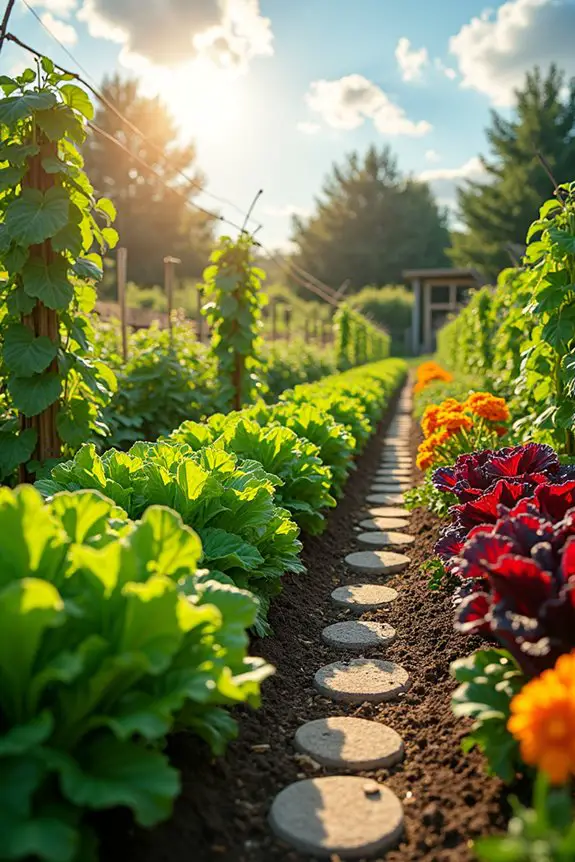
When it comes to creating a sustainable vegetable garden, using a block planting strategy is a game changer. Not only does it help you make the most of every inch in your garden, but it also gives your plants a chance to thrive together, fostering that lovely sense of community we all enjoy. Just like potlucks, some plants work better together, helping each other out while minimizing bare soil and maximizing harvests—talk about teamwork.
So, how do you get started with block planting? First, think about the plants that can buddy up—squash and beans, for example, are a match made in garden heaven. The beans can climb the squash leaves for support, while the squash keeps the ground shaded, which helps with moisture retention. That’s what I call a win-win!
Now, visualize your garden like a compact city block. Each vegetable type gets its own mini neighborhood. Aim for 3-foot-wide blocks, allowing enough space for you to squeeze in and tend to your plants without feeling like you’re in a wrestling match with the zucchini. After all, we want to avoid any unexpected bursts of veggie rage.
As you plant, give each type of vegetable ample room to share its space and sunlight without feeling cramped. A good rule of thumb is spacing them around 12 to 18 inches apart, depending on the plant’s size. Don’t forget about caterers of the garden world—pollinators and beneficial insects love a healthy mix. If you can, mix in some flowering herbs or colorful marigolds to liven up those blocks even more. Not only do they look great, but they’ll also bring in the buzzworthy crowd.
While you’re planting, it’s perfectly okay to get a little experimental. I once decided to plant a swath of bright green lettuce nestled up against some fiery red Swiss chard, and I couldn’t believe how fabulous it looked—and tasted! Who knew such a vibrant combo would work so well?
Just keep in mind that some plants might start hogging space, so be prepared to intervene like a garden referee if necessary.
Trust me, when you embrace block planting, you’ll find that not only does your garden flourish, but it also becomes a colorful patchwork quilt that exudes joy and purpose. So let your plants come together like old friends, share resources, and watch your sustainable garden thrive beautifully.
7. Aesthetic Raised Bed Arrangement
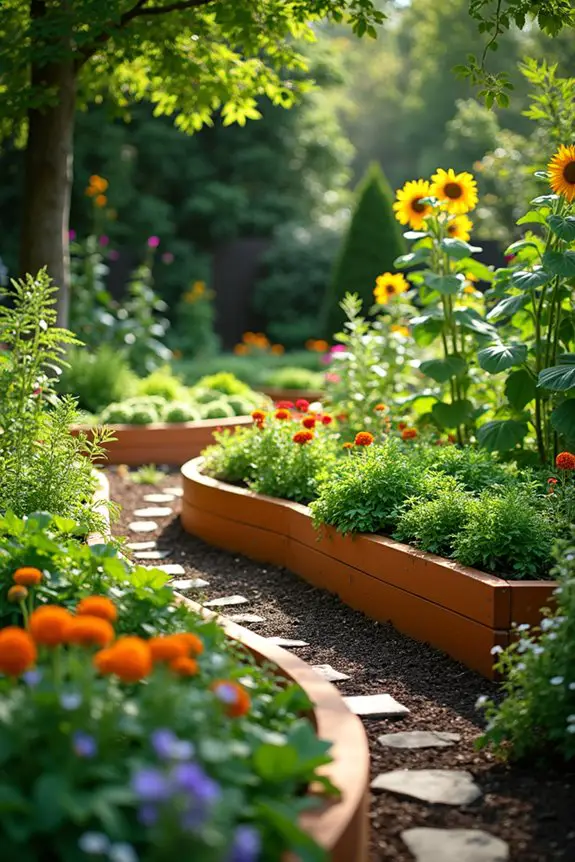
When you think about raising vegetables in your garden, the first thing that might pop into your mind is rows and rows of planted seeds, right? Well, let me introduce you to the wonderful world of aesthetic raised bed arrangements and why they’re so much more than just a pretty face. These beds aren’t only functional, maximizing your garden space, but they also add a dash of charm. Imagine stepping into your backyard and feeling like you’re entering a cozy green retreat—who wouldn’t want that?
To get started, consider building long, raised beds instead of the typical squared-off ones. I remember when I first tried it; I thought I was losing my gardening mind, but it turned out to be a stroke of genius. A single long bed can be less expensive and gives you ample opportunity to plant different crops side by side.
Picture it: the rainbow of colors from your vegetables, all lined up in a neat row, making you feel like a proud garden curator. Once I saw how inviting my garden looked, it inspired me to spend more time out there nurturing my plants.
Now, let’s add a little flair. One nifty trick I learned was to create crescent-shaped beds that follow the contour of existing landscape features. You know those odd little nooks in your backyard that seem useless? Bam! Turn them into curved beds. Not only will it improve accessibility—because nobody likes wrestling with weeds—but it creates an aesthetic flow that transforms your garden into an art piece.
It’s like giving your plants their own cozy little alcoves to flourish in.
As you plan, remember the importance of spacing. Each veggie needs room to breathe, so think carefully about how far apart to plant them. A good spacing rule is 12 to 18 inches. You want your crops to thrive, not fight for sunlight like they’ve just discovered a last cookie.
On that note, don’t forget to intersperse some pretty little flowers or herbs. They’ll attract pollinators and benefit your veggies while adding that extra “wow” factor. Plus, a cheerful marigold makes even the grumpiest neighbor smile.
Lastly, allow yourself to play. Gardening should be a joy, not just chores. So mix and match your vegetables, experiment with shapes, and let your creativity spill onto the beds like dirt on your favorite gardening gloves. Embrace the planning stage like it’s a huge puzzle waiting to be solved, and trust me, your garden will flourish while you have a blast making it unique to you.
With a little vision and some elbow grease, your aesthetic raised bed arrangement can become a lovely gathering space for both you and your plants.
8. Sculptural Bed Shapes
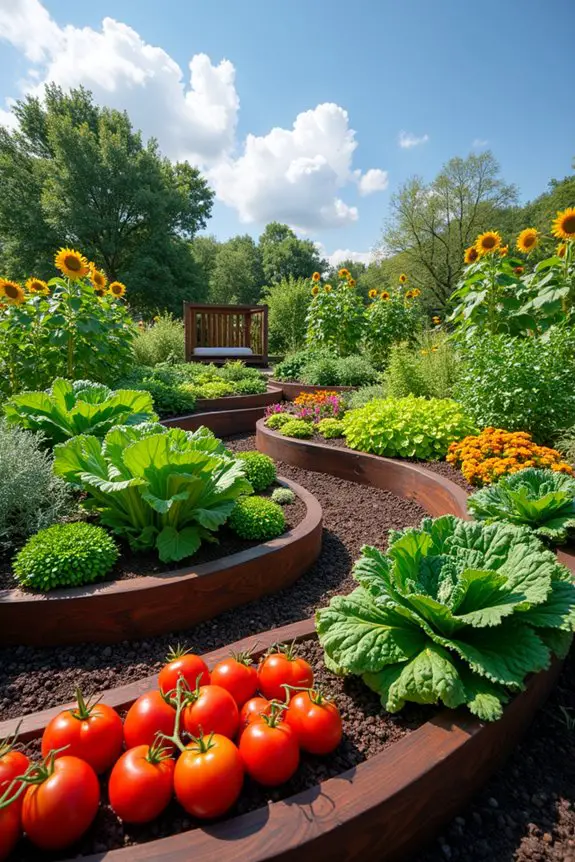
When it comes to vegetable gardening, why not spice things up with sculptural bed shapes? This creative approach not only enhances functionality by making the most of limited space but also adds an artistic flair to your garden.
Imagine walking through your lush green oasis, where the curves and angles of your beds draw the eye and invite exploration, all while serving up fresh veggies.
To kick things off, think beyond traditional rectangles or squares. While those classic shapes do the job, consider designing beds that spiral, wave, or even form zig-zags. I once tried a wavy bed layout in my garden, and honestly, I felt like a garden Picasso.
It didn’t just look cool, but it also made my growing veggies more accessible and easier to tend. You see, sculptural shapes create nooks and crannies where plants can thrive together.
Now, let’s talk about vegetable block planting! Instead of spreading plants out in cunning little rows, group them together in blocks. This technique maximizes space, reduces bare soil, and creates a beautiful tapestry of colors and textures.
Imagine a block of vibrant tomatoes standing proud next to a flourish of greens—pure visual poetry. Keep an eye on spacing; some plants will need a little room to breathe, like a bustling family at a holiday dinner. A good rule of thumb? Leave about 12 to 18 inches between each group.
And hey, while you’re eyeballing those shapes, don’t forget to indulge your creative side. Pick a few vibrant flowers to sprinkle in between your veggies, turning the whole setup into an edible flower show.
A pop of color from those marigolds? Instant happiness booster—both for you and any pollinators that stop by.
9. Sculptural Garden Bed Features
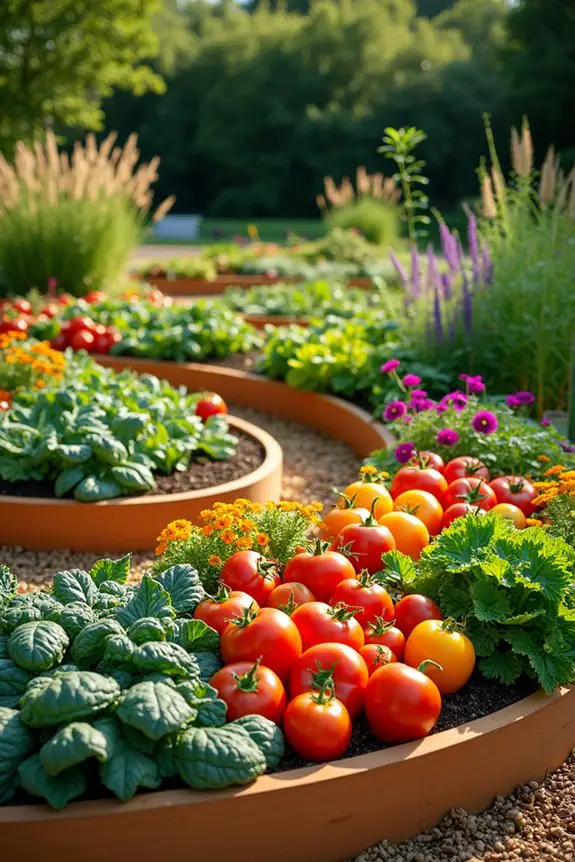
When you’re designing your garden, think about the beauty and practicality of sculptural bed features alongside a block planting strategy. This approach not only helps you maximize space but also creates an incredibly inviting vibe. Just picture it—curvy beds filled with luscious veggies, growing right next to each other in vibrant blocks, transforming your garden into a visually stunning landscape.
So, what does it mean to implement sculptural bed features? Imagine beds shaped like gentle waves or graceful spirals. They can add character and flow to your garden, making it a delightful place to chill and grow your veggies.
While you’re at it, group your plants together in blocks. This can lead to improved air circulation and makes it easier to care for your plants. I’ve found that block planting not only reduces wasted space but also adds an artistic flare that’s hard to resist.
Now, choose your veggies wisely—think colorful tomatoes, leafy greens, or even a splash of vibrant peppers. It’s like putting together your favorite meal, where each flavor complements the other. When I tried this in my own garden, I was amazed at how quickly those blocks turned into a lovely mosaic of colors and textures.
And, don’t skimp on spacing—allow about 12 to 18 inches so your plants can breathe and grow like they own the place.
Lastly, sprinkle in a few edible flowers or eye-catching herbs, and oh boy, you have a garden that’s not just functional but an aesthetic feast for the eyes. Who knew that vegetable gardening could look so good? It’s like a chic dinner party, only you get to eat the centerpieces.
10. Sculptural Bed Feature Styles
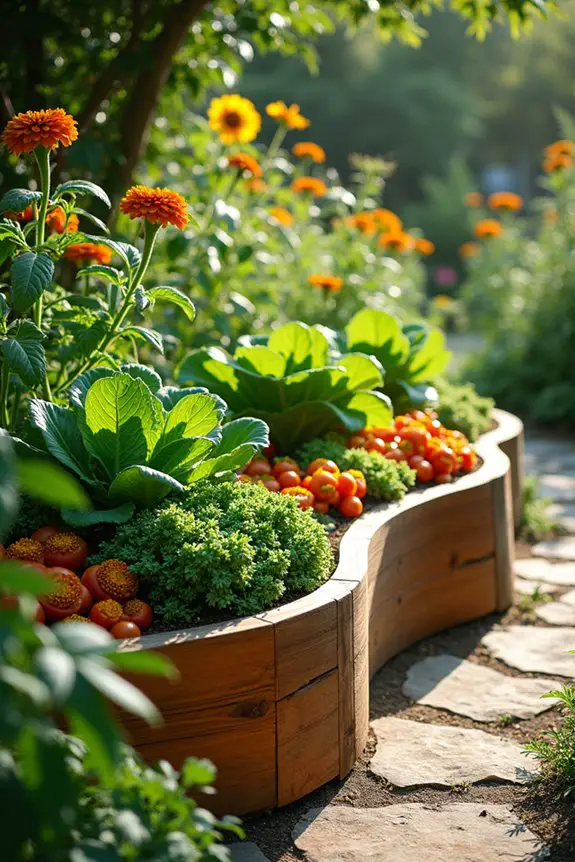
When it comes to designing a vegetable garden, there’s nothing quite like the charm of sculptural bed features. Imagine gentle curves and flowing lines that inspire you to spend more time soaking up the sun while tending to your plants. Not only do these shapes look good, but they also improve function—creating space for your veggies to thrive in cozy, organized blocks.
Think about it: a raised garden bed shaped like a swooping wave isn’t just visually stunning; it makes it easier to reach all those delicious plants you’re nurturing. You can plant colorful tomatoes and leafy greens in dense blocks, where they can bask in the sunlight adjacent to each other, resembling a beautiful patchwork of produce. Trust me, when I first stepped into my own garden filled with these artistic beds, it felt like walking into a living canvas.
And I can assure you, nothing beats the joy of gathering your homegrown harvest from a garden that looks as good as it tastes.
Now, let’s talk sizing. Aim for dimensions that allow for easy access—about 3-4 feet wide for pathways, so you don’t feel like a contortionist just to pick a pepper or two. And don’t forget that sweet spot of spacing—give your plants about 12 to 18 inches apart. It’s a little room to grow, you know? Plus, it fosters better air circulation, which means healthier plants and fewer pesky pests crashing your garden party.
Oh, and here’s a pro tip: sprinkle in some bold-colored herbs or edible flowers among those veggies. Those pops of color not only enhance beauty but also draw in friendly pollinators. Picture it—dazzling marigolds dancing next to your green beans.
Who knew being a plant parent could be this fun? With sculptural beds, your garden will feel like an artistic expression, a lush retreat, and a source of fresh ingredients, all rolled into one delightful space.
Plant Companion Pairing Strategies
Ever wonder how some gardens seem to burst with life while others… well, not so much? One secret’s in companion planting!
Pairing plants can boost growth, deter pests, and even enhance flavors. For instance, tomatoes love hanging out with basil. They not only complement each other in your favorite pasta sauce but also keep pests at bay.
Have you tried planting radishes with cucumbers? The radishes break up the soil, helping cucumbers thrive.
And let’s not forget the classic trio of corn, beans, and squash. It’s like a party in your vegetable garden ideas!

